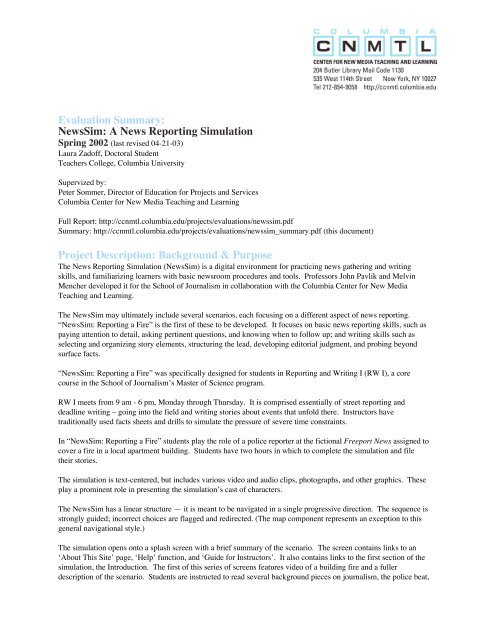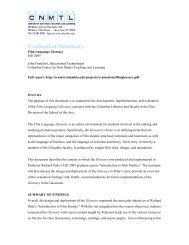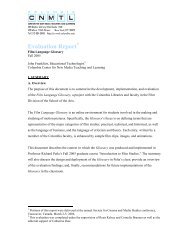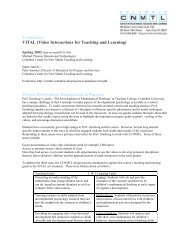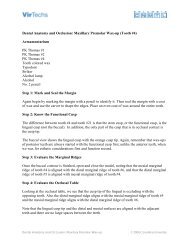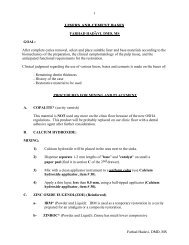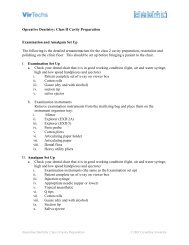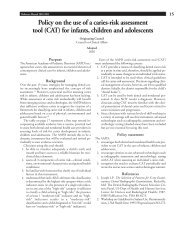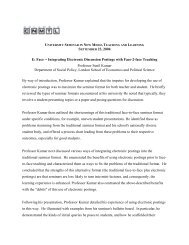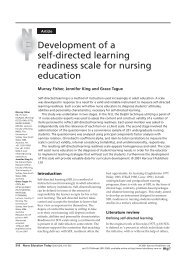Evaluation Summary - Columbia Center for New Media Teaching ...
Evaluation Summary - Columbia Center for New Media Teaching ...
Evaluation Summary - Columbia Center for New Media Teaching ...
You also want an ePaper? Increase the reach of your titles
YUMPU automatically turns print PDFs into web optimized ePapers that Google loves.
<strong>Evaluation</strong> <strong>Summary</strong>:<br />
<strong>New</strong>sSim: A <strong>New</strong>s Reporting Simulation<br />
Spring 2002 (last revised 04-21-03)<br />
Laura Zadoff, Doctoral Student<br />
Teachers College, <strong>Columbia</strong> University<br />
Supervized by:<br />
Peter Sommer, Director of Education <strong>for</strong> Projects and Services<br />
<strong>Columbia</strong> <strong>Center</strong> <strong>for</strong> <strong>New</strong> <strong>Media</strong> <strong>Teaching</strong> and Learning<br />
Full Report: http://ccnmtl.columbia.edu/projects/evaluations/newssim.pdf<br />
<strong>Summary</strong>: http://ccnmtl.columbia.edu/projects/evaluations/newssim_summary.pdf (this document)<br />
Project Description: Background & Purpose<br />
The <strong>New</strong>s Reporting Simulation (<strong>New</strong>sSim) is a digital environment <strong>for</strong> practicing news gathering and writing<br />
skills, and familiarizing learners with basic newsroom procedures and tools. Professors John Pavlik and Melvin<br />
Mencher developed it <strong>for</strong> the School of Journalism in collaboration with the <strong>Columbia</strong> <strong>Center</strong> <strong>for</strong> <strong>New</strong> <strong>Media</strong><br />
<strong>Teaching</strong> and Learning.<br />
The <strong>New</strong>sSim may ultimately include several scenarios, each focusing on a different aspect of news reporting.<br />
“<strong>New</strong>sSim: Reporting a Fire” is the first of these to be developed. It focuses on basic news reporting skills, such as<br />
paying attention to detail, asking pertinent questions, and knowing when to follow up; and writing skills such as<br />
selecting and organizing story elements, structuring the lead, developing editorial judgment, and probing beyond<br />
surface facts.<br />
“<strong>New</strong>sSim: Reporting a Fire” was specifically designed <strong>for</strong> students in Reporting and Writing I (RW I), a core<br />
course in the School of Journalism’s Master of Science program.<br />
RW I meets from 9 am - 6 pm, Monday through Thursday. It is comprised essentially of street reporting and<br />
deadline writing – going into the field and writing stories about events that unfold there. Instructors have<br />
traditionally used facts sheets and drills to simulate the pressure of severe time constraints.<br />
In “<strong>New</strong>sSim: Reporting a Fire” students play the role of a police reporter at the fictional Freeport <strong>New</strong>s assigned to<br />
cover a fire in a local apartment building. Students have two hours in which to complete the simulation and file<br />
their stories.<br />
The simulation is text-centered, but includes various video and audio clips, photographs, and other graphics. These<br />
play a prominent role in presenting the simulation’s cast of characters.<br />
The <strong>New</strong>sSim has a linear structure — it is meant to be navigated in a single progressive direction. The sequence is<br />
strongly guided; incorrect choices are flagged and redirected. (The map component represents an exception to this<br />
general navigational style.)<br />
The simulation opens onto a splash screen with a brief summary of the scenario. The screen contains links to an<br />
‘About This Site’ page, ‘Help’ function, and ‘Guide <strong>for</strong> Instructors’. It also contains links to the first section of the<br />
simulation, the Introduction. The first of this series of screens features video of a building fire and a fuller<br />
description of the scenario. Students are instructed to read several background pieces on journalism, the police beat,
fire coverage, basic grammar and math <strong>for</strong> reporters be<strong>for</strong>e proceeding.<br />
Next, students are introduced to the editors at the Freeport <strong>New</strong>s. A photo and an audio clip of the editors speaking<br />
directly to the viewer accompany each bio-sketch. One of the choices students face in this section of the simulation<br />
is which editor to visit next.<br />
In the next section, The Police Beat, students visit the Freeport Police Station. A veteran police reporter explains<br />
how to decipher fire codes over the police scanner and how to cover a fire story.<br />
Using the simulation’s map and cross directory tools, students make their way to the scene of the fire and start<br />
reporting. They hear (and see) the Fire Marshal give an account of the fire and then interview him by selecting from<br />
a list of questions. Students may also listen to and question additional sources, including a hospital official, the<br />
building’s owner, and a firefighter.<br />
In the final two sections of the simulation, students are briefed on how to structure a lead story and provided space<br />
in which to write their own stories. Using the button at the bottom of the screen, students submit their stories to the<br />
Freeport <strong>New</strong>s (their instructors).<br />
Overview of the <strong>Evaluation</strong> Process<br />
This evaluation sought to determine the effectiveness of the <strong>New</strong>sSim as a teaching tool by understanding the<br />
learning experiences it promotes. To do this, we monitored participants’ perceptions of and reactions to the<br />
<strong>New</strong>sSim, especially in regard to its functionality and navigation. We also considered the degree to which its<br />
various features and activities achieved their learning objectives. Based on our findings, we recommend ways in<br />
which to improve the simulation.<br />
We employed several research methods; namely, non-participant observation, interviews, a focus group, and a<br />
survey. Our subjects included five first-year journalism students and three students from the faculty partner’s<br />
Exploring <strong>New</strong> <strong>Media</strong> class. All but one student completed the survey. The Journalism students were also observed<br />
and interviewed. The <strong>New</strong> <strong>Media</strong> students comprised the focus group. 1<br />
The faculty partner recruited one of the Journalism students. The other four responded to a mass e-mailing of firstsemester<br />
journalism students. The ages and backgrounds of these students reflected the diversity common among<br />
students in RW I.<br />
The three students from the faculty partner’s <strong>New</strong> <strong>Media</strong> class were asked to participate by the faculty partner.<br />
None of these students is in the School of Journalism. Their purposes in testing the simulation there<strong>for</strong>e related<br />
more to exploring technology than to learning or practicing news reporting and writing skills.<br />
These characteristics of the student participants are significant because they reflect a certain level of interest in and<br />
partiality toward the simulation.<br />
Also important is that none of the students used the simulation as developers intended. The simulation was designed<br />
<strong>for</strong> use in RW I but had not as yet been introduced to the course. Because context critically shapes experience, the<br />
findings of this evaluation may not be generalizable to a classroom setting.<br />
Findings<br />
All the students responded positively to the <strong>New</strong>sSim. They considered it worthwhile, interesting, and fun. In<br />
1 Also interviewed were the project’s faculty partner, a RW I professor, and the CCNMTL Project Manager. The comments and<br />
suggestions of another RWI professor were obtained at a group meeting.<br />
2<br />
2
particular, they appreciated its thoroughness, incorporation of multi-media, and integration of different sections and<br />
resources. The scenario and the tasks appeared to be both attractive and motivating to them.<br />
More specifically, students valued the <strong>New</strong>sSim’s audio and video components <strong>for</strong> setting the scene and enhancing<br />
the realism of the experience. They said the audio components helped them practice gathering facts by listening to<br />
sources. Students especially appreciated being able to replay sources’ comments, comparing one source with<br />
another, and asking sources to repeat themselves. Students and professors alike valued these aspects of the<br />
simulation <strong>for</strong> their realism and relevance to news reporting. The two-hour time limit received similar praise.<br />
Some students expressed a desire <strong>for</strong> more video and/or photos of the fire scene. As one student commented, a<br />
comprehensive view of the fire scene and surrounding area is crucial to coverage:<br />
Navigation<br />
If you are a reporter on a beat, the physical place where you find yourself, in my mind, is the most<br />
important thing. That and who to talk to, of course…I mean, there was an example there where it<br />
said the fire gutted the building or it de-strayed the building -- you can’t evaluate that without<br />
seeing it.<br />
Students found the simulation’s linear architecture easy to navigate but also somewhat frustrating. Difficulties arose<br />
particularly when students were writing their stories and wanted to go back and check facts. Returning to the map or<br />
a specific interview proved cumbersome at best. Students also lost precious time when they discovered that doing<br />
so caused their stories-in-progress to be wiped from the screen. To remedy this un<strong>for</strong>tunate situation one student<br />
suggested,<br />
….have[ing] an extra bar over here (left margin), where, if you started to write your story, you<br />
[could] get back individually to whichever of these people you want to talk to so you don’t have to<br />
go through all to get to the fire chief...The fire chief was the most important interview, [and] I<br />
think…the first interview…. But it was difficult to go back to him.<br />
The map feature was likewise a source of both possibility and some difficulty <strong>for</strong> students. One problem was that it<br />
represented a significant shift in navigational style. Some students found the map screen’s <strong>for</strong>mat confusing. Others<br />
spent an inordinate amount of time using it. For instance, one student identified her present location and the one she<br />
wanted to reach, then plotted and studied the route be<strong>for</strong>e proceeding. While an authentic use of a map, this was not<br />
the best way to move around the site.<br />
Still, students valued the map’s more exploratory navigational style <strong>for</strong> allowing them a measure of control over<br />
their use of the site.<br />
Learning Objectives<br />
The <strong>New</strong>sSim had varying degrees of success in regard to its learning objectives. Survey results (n=7) indicate that<br />
it was most successful at conveying the importance of fact-checking and paying close attention to details. Students<br />
said they used the map to confirm and correct names and addresses.<br />
Students thought that listening to and taking down in<strong>for</strong>mation from the police scanner was especially constructive<br />
in this regard. As one student stated, “I thought the scanner was good…it was useful <strong>for</strong> the codes and having to<br />
listen [<strong>for</strong>] the really important [in<strong>for</strong>mation].”<br />
Students also felt that the <strong>New</strong>sSim taught them what sources to consult in covering a fire story. As one student<br />
described:<br />
I learned to go to the fire marshal first…Kind of the chain of events…If you were at a murder scene<br />
3<br />
3
you would probably need to find the police chief as opposed to just running around and just trying<br />
to chaotically grab somebody [to interview].<br />
The majority of students also felt that the simulation was effective at building investigative skills. At the same time,<br />
their remarks reveal a desire <strong>for</strong> even more practice this area. For example, one student recounted wanting to pursue<br />
an alternative lead:<br />
That would have been very interesting, extremely interesting…I wanted to talk to somebody who<br />
worked in arson investigation,…[but] couldn’t do it…So that’s a whole line/set of communication<br />
that is just shut off….<br />
Another student cited a need <strong>for</strong> additional sources of in<strong>for</strong>mation, such as a news archive:<br />
One thing that could be useful [and] that…is not here…[is] be[ing able] to call up clips, consult, do<br />
a search on this building, like if there was a fire[there] a year ago, that kind of thing.<br />
A third student discussed the possibility of visiting other locations on the map:<br />
….If you look in that directory (included with the map), that would be a little unrealistic because if<br />
there is a fire in their building they (the neighbors) are not going to be home, so, it would be a<br />
problem…to contact them. I might go to the shelter, the Red Cross…[It]…should have popped up<br />
(when clicked on in the directory) because that’s where people would be….<br />
All but one student considered the simulation an effective tool <strong>for</strong> practicing writing skills. When asked to describe<br />
their writing experiences, students recalled the difficult decisions the simulation required them to make. For<br />
example, most students cited the importance of learning to decide where material should go in a story; all said they<br />
had struggled with this task. Indeed, students were observed to spend considerable time wording their leads, often<br />
reviewing and revising them repeatedly.<br />
The writing activity also required students to practice using editorial judgment. One of the more frequently cited<br />
aspects of the learning experience was deciding whether to include a firefighter’s suggestion of arson, which is<br />
contradicted by the fire marshal. As one student explained:<br />
I think the cause of the fire was an interesting thing. The fire marshal, who is the official source,<br />
was saying that arson is not suspected, and then you have two sources, including a firefighter,<br />
saying that arson was suspected. I thought that the contradiction in the cause of the fire was very<br />
good because that is very common.<br />
Students found the simulation less helpful <strong>for</strong> learning to recognize when a fire is worth covering. The scenario<br />
only involves one fire, so there is nothing <strong>for</strong> students to compare it to. Also, students are told which police code to<br />
listen <strong>for</strong> on the scanner, thus eliminating the need to consider the relative news worthiness of any other code.<br />
The simulation also fell short in developing students’ interviewing skills. Survey respondents explained that<br />
knowing how to <strong>for</strong>mulate interview questions is a critically important news reporting skill but that the simulation<br />
only requires students to choose the order in which they are asked; all said that they asked each source every<br />
question on the lists they were presented. As one student opined:<br />
I don’t think it really did help with my interviewing because I wasn’t <strong>for</strong>ming the questions. They<br />
were being <strong>for</strong>med <strong>for</strong> me. I know this would be a higher level of technology but if the reporter<br />
could <strong>for</strong>m the questions that would be important because that’s the key, knowing what to<br />
ask…The reporter needs to be thinking about what do you ask in this situation and that is<br />
something that you can’t get here. Actually, having to listen to what [is] said is actually more<br />
useful than the questions. The fire marshal, he was talking fast, he was hard to quote and a couple<br />
of things that he said were a little confusing, which is realistic. So that, in a way, was more realistic<br />
than the questions.<br />
Students also felt that the simulation should have offered them more opportunity to direct the course of the<br />
investigation. One student suggested including,<br />
4<br />
4
….choices like, “Where do you want to go next? Who do you want to talk to next?” You [could]<br />
have this list of people and…choices like, “Do you want to look <strong>for</strong> phone numbers in the<br />
directory,…go to the scene of the fire,….go back to your office…?”<br />
A number of students felt that the <strong>New</strong>sSim should allow users to make mistakes and to face the consequences of<br />
doing so. As one student elaborated:<br />
I think that in terms of teaching the actual skills, that if there were more opportunities to make<br />
mistakes I think there would be more opportunities to learn. Because a lot of the time, as [student<br />
2] had said, if you clicked the wrong button you would go to the correct screen<br />
anyway…Particularly when asking the questions, when you are interviewing the people, like<br />
maybe [have] someone [get] upset or offended or something and [say], “I am not going to talk to<br />
you anymore,” or something like that. And then kind of you lose your source or your source<br />
doesn’t talk anymore. I mean, it makes the site a lot more complicated but I think the students<br />
would learn more….<br />
The <strong>New</strong>sSim’s Potential <strong>for</strong> Enhancing RW I<br />
All five journalism students thought the <strong>New</strong>sSim would be helpful in RWI. They suggested using it early in the<br />
course, or targeting it to students coming to journalism from other disciplines. All considered it most appropriate <strong>for</strong><br />
those who know less about journalism than they do. A couple students thought it could be used at the undergraduate<br />
level.<br />
An RW I professor added that the <strong>New</strong>sSim might be helpful to students <strong>for</strong> whom English is a second language.<br />
He reiterated that one of the purposes of the course is to put entering students, whose backgrounds and experiences<br />
typically vary, on more equal footing with one another.<br />
Recommendations<br />
The <strong>New</strong>sSim proved to be an innovative tool <strong>for</strong> practicing news reporting and writing skills, one that student<br />
testers universally valued. At the same time, however, we found a bit of a gap between what students regard as the<br />
fundamental tasks of news reporting and the tasks the <strong>New</strong>sSim involves.<br />
Students felt that the simulation’s interviewing component did not provide enough opportunity to make decisions.<br />
This element of the simulation should be restructured so that students have a greater hand in determining what<br />
questions to ask, and when. One way to do this is to make the lists of questions longer and impose a selection<br />
constraint, such as a certain number or amount of time (e.g., “This source only has time <strong>for</strong> three questions…”).<br />
This would require students to decide what questions are most important at a given point in time. Such a change<br />
would enhance the simulation’s realism and also make it more engaging.<br />
Students also wanted to be able to pursue leads that are not currently available in the <strong>New</strong>sSim. We suggest<br />
exploring the possibility of developing additional plot lines, even if they are false under the scenario. Doing so<br />
would encourage students to pay even greater attention to detail. It would also test their beliefs and understandings.<br />
Finally, it would allow students to make mistakes, something they wished the simulation could do.<br />
A less linear design could also be applied to the simulation’s in<strong>for</strong>mation resources and expository sections.<br />
Specifically, we suggest making the Background Readings available throughout the simulation so that the learner<br />
controls the timing of their support functions. Similarly, the writing space should be a non-sequenced element.<br />
Students could then begin planning and organizing their stories at the outset of the simulation.<br />
In addition, the background readings could be made more accessible by including subheadings on the menu. This<br />
relates to the earlier point about allowing students to draw upon resources as they need them in practice, not as<br />
someone else thinks they should. Students roundly rejected the idea that the background readings constituted<br />
5<br />
5
lessons to be learned prior to beginning the simulation. Having background readings exist as independent resources<br />
within the environment would also provide professors more flexibility to customize the <strong>New</strong>sSim, as its developers<br />
intended.<br />
The content of the background readings should also refer directly to the scenario. For example, most of the students<br />
appreciated the math reading but were puzzled when the scenario offered no opportunity to apply it.<br />
Students expressed a desire <strong>for</strong> additional resources, such as databases and news archives, citing their central<br />
importance to working journalists. Including such resources in the simulation would give students an opportunity to<br />
practice using them in a realistic context. Although it is aimed at beginners, we feel the <strong>New</strong>sSim would benefit<br />
through the incorporation of increased resources, greater complexity, and more challenges <strong>for</strong> the learner.<br />
6<br />
6


